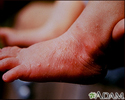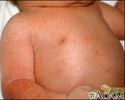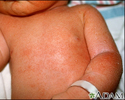Skin findings in newborns
Newborn skin characteristics; Infant skin characteristics; Neonatal care - skin
A newborn infant's skin goes through many changes both in appearance and texture.
Information
The skin of a healthy newborn at birth has:
- Deep red or purple skin and bluish hands and feet. The skin darkens before the infant takes his or her first breath (when they make that first vigorous cry).
- A thick, waxy substance called vernix covering the skin. This substance protects the fetus's skin from the amniotic fluid in the womb. Vernix should wash off during the baby's first bath.
- Fine, soft hair (lanugo) that may cover the scalp, forehead, cheeks, shoulders, and back. This is more common when an infant is born before the due date. The hair should disappear within the first few weeks of the baby's life.
Newborn skin will vary, depending on the length of the pregnancy. Premature infants have thin, transparent skin. The skin of a full-term infant is thicker.
By the baby's second or third day, the skin lightens somewhat and may become dry and flaky. The skin still often turns red when the infant cries. The lips, hands, and feet may turn bluish or spotted (mottled) when the baby is cold.
Other changes may include:
-
Milia
, (tiny, pearly-white, firm raised bumps on the face) which disappear on their own.
Milia
Milia are tiny white bumps or small cysts on the skin. They are almost always seen in newborn babies.
Read Article Now Book Mark Article - Mild acne that most often clears in a few weeks. This is caused by some of the mother's hormones that stay in the baby's blood.
- Erythema toxicum. This is a common, harmless rash that looks like little pustules on a red base. It tends to appear on the face, trunk, legs, and arms about 1 to 3 days after delivery. It disappears by 1 week.
Colored birthmarks or skin markings may include:
-
Congenital nevi
are moles (darkly pigmented skin markings) that may be present at birth. They range in size from as small as a pea to large enough to cover an entire arm or leg, or a large portion of the back or trunk. Larger nevi carry a greater risk of becoming skin cancer. The health care provider should follow all nevi.
Congenital nevi
A birthmark is a skin marking that is present at birth. Birthmarks include cafe-au-lait spots, moles, and Mongolian spots. Birthmarks can be red or...
 ImageRead Article Now Book Mark Article
ImageRead Article Now Book Mark Article - Mongolian spots are blue-gray or brown spots. They can emerge on the skin of the buttocks or back, mainly in dark-skinned babies. They should fade within a year.
- Café-au-lait spots are light tan, the color of coffee with milk. They often appear at birth, or may develop within the first few years. Children who have many of these spots, or large spots, may be more likely to have a condition called neurofibromatosis.
Red birthmarks may include:
- Port-wine stains are growths that contain blood vessels (vascular growths). They are red to purplish in color. They are frequently seen on the face, but may occur on any area of the body.
- Hemangiomas are a collection of capillaries (small blood vessels) that may appear at birth or a few months later.
-
Stork bites
are small red patches on the baby's forehead, eyelids, back of the neck, or upper lip. They are caused by stretching of the blood vessels. They usually go away within 18 months.
Stork bites
A stork bite is a common type of birthmark seen in a newborn. It is most often temporary. The medical term for a stork bite is nevus simplex. A sto...
 ImageRead Article Now Book Mark Article
ImageRead Article Now Book Mark Article
References
Lissauer T. Physical examination of the newborn. In: Gleason CA, Devaskar SU, eds. Avery's diseases of the newborn . 9th ed. Philadelphia, PA: Elsevier Saunders; 2012:chap 29.
Olsson JM. The newborn. In: Kliegman RM, Stanton BF, St. Geme JW, Schor NF, eds. Nelson Textbook of Pediatrics . 20th ed. Philadelphia, PA: Elsevier; 2016:chap 9.
Sahin, M. Neurocutaneous syndromes. In: Kliegman RM, Stanton BF, St. Geme JW, Schor NF, eds. Nelson Textbook of Pediatrics . 20th ed. Philadelphia, PA: Elsevier; 2016:chap 596.
-
Erythema toxicum on the foot - illustration
Newborn infants may have Erythema toxicum, a rash that is characterized by patchy redness with central vesicles. The rash is temporary, and the location may move (transient). (Image courtesy of the Centers for Disease Control and Prevention.)
Erythema toxicum on the foot
illustration
-
Skin characteristics - illustration
It is common for a newborn to have fine, soft, light-colored hair called lanugo covering the forehead, cheeks, shoulders and back. Some newborns also have enlarged sebaceous glands appearing as small white dots on the face called milia. Both of these characteristics are normal and will disappear after a few weeks.
Skin characteristics
illustration
-
Milia - nose - illustration
Milia is seen in a newborn infant as tiny, white, elevated spots in the skin. On occasion, there may be a narrow red halo around the base. This is a normal and self-limiting condition of the newborn and disappears over a period of months.
Milia - nose
illustration
-
Cutis marmorata on the leg - illustration
Cutis marmorata is a common phenomenon in newborn infants. It consists of alternating areas of dilated and constricted blood vessels, which gives the skin a red and white marbled appearance. It is most obvious when the skin is cool.
Cutis marmorata on the leg
illustration
-
Miliaria crystallina - close-up - illustration
Miliaria crystallina occurs when sweat is retained in the pores in the skin. This close-up photograph shows the tiny, clear blisters that rupture easily. There is no associated inflammation, so no redness is present under or around the blisters. This condition often occurs in newborn infants.
Miliaria crystallina - close-up
illustration
-
Miliaria crystallina - chest and arm - illustration
Miliaria crystallina occurs when sweat is retained in the pores of the skin, producing tiny, clear blisters that break easily. There is no associated inflammation, so no redness is present under or around the blisters. This condition often occurs in newborn infants and can cover an extensive area of the body.
Miliaria crystallina - chest and arm
illustration
-
Miliaria crystallina - chest and arm - illustration
Miliaria crystallina occurs when sweat is retained in the pores in the skin, producing tiny, clear blisters that rupture easily. There is no associated inflammation, so no redness is present under or around the blisters. This condition often occurs in newborn infants and can cover an extensive area of the body.
Miliaria crystallina - chest and arm
illustration
-
Erythema toxicum on the foot - illustration
Newborn infants may have Erythema toxicum, a rash that is characterized by patchy redness with central vesicles. The rash is temporary, and the location may move (transient). (Image courtesy of the Centers for Disease Control and Prevention.)
Erythema toxicum on the foot
illustration
-
Skin characteristics - illustration
It is common for a newborn to have fine, soft, light-colored hair called lanugo covering the forehead, cheeks, shoulders and back. Some newborns also have enlarged sebaceous glands appearing as small white dots on the face called milia. Both of these characteristics are normal and will disappear after a few weeks.
Skin characteristics
illustration
-
Milia - nose - illustration
Milia is seen in a newborn infant as tiny, white, elevated spots in the skin. On occasion, there may be a narrow red halo around the base. This is a normal and self-limiting condition of the newborn and disappears over a period of months.
Milia - nose
illustration
-
Cutis marmorata on the leg - illustration
Cutis marmorata is a common phenomenon in newborn infants. It consists of alternating areas of dilated and constricted blood vessels, which gives the skin a red and white marbled appearance. It is most obvious when the skin is cool.
Cutis marmorata on the leg
illustration
-
Miliaria crystallina - close-up - illustration
Miliaria crystallina occurs when sweat is retained in the pores in the skin. This close-up photograph shows the tiny, clear blisters that rupture easily. There is no associated inflammation, so no redness is present under or around the blisters. This condition often occurs in newborn infants.
Miliaria crystallina - close-up
illustration
-
Miliaria crystallina - chest and arm - illustration
Miliaria crystallina occurs when sweat is retained in the pores of the skin, producing tiny, clear blisters that break easily. There is no associated inflammation, so no redness is present under or around the blisters. This condition often occurs in newborn infants and can cover an extensive area of the body.
Miliaria crystallina - chest and arm
illustration
-
Miliaria crystallina - chest and arm - illustration
Miliaria crystallina occurs when sweat is retained in the pores in the skin, producing tiny, clear blisters that rupture easily. There is no associated inflammation, so no redness is present under or around the blisters. This condition often occurs in newborn infants and can cover an extensive area of the body.
Miliaria crystallina - chest and arm
illustration
Review Date: 11/19/2015
Reviewed By: Neil K. Kaneshiro, MD, MHA, Clinical Assistant Professor of Pediatrics, University of Washington School of Medicine, Seattle, WA. Also reviewed by David Zieve, MD, MHA, Isla Ogilvie, PhD, and the A.D.A.M. Editorial team.







